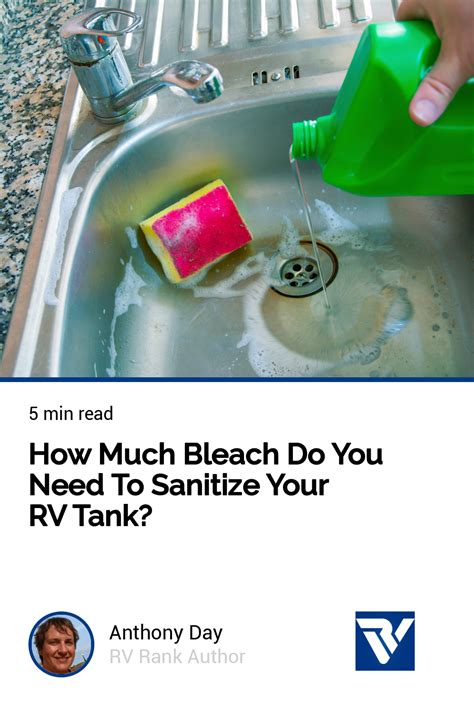RV Water Tank: Ensuring Clean Water with Bleach
Maintaining clean water in your RV's fresh water tank is crucial for your health and the longevity of your system. While filters help, regular sanitizing is essential. Bleach is a common and effective method, but it's important to understand the proper procedure to avoid damaging your RV's plumbing and ensuring safe drinking water. This guide will walk you through the process, addressing common questions and concerns.
Why Sanitize Your RV Water Tank?
Over time, your RV's fresh water tank can accumulate bacteria, algae, and other microorganisms. These contaminants can lead to unpleasant tastes and odors in your water and, more importantly, can cause illness. Regular sanitizing prevents these problems, ensuring you have clean, safe water for drinking, cooking, and showering. Even if you only use treated water, sanitizing is a preventative measure to safeguard your health.
How Often Should I Sanitize My RV Water Tank?
The frequency of sanitizing depends on several factors, including how often you use your RV and the climate you store it in. As a general rule of thumb, it's recommended to sanitize your tank at least twice a year, ideally before and after each season of use. If you store your RV for extended periods, more frequent sanitizing is advised. Storing your RV with a full tank is recommended so no debris accumulates. Remember to drain and refill on return.
What Kind of Bleach Should I Use?
Use only unscented, household bleach without added detergents or other chemicals. Avoid using colored bleaches or bleach with additives as these can damage your RV's plumbing system. Ensure the bleach is at the appropriate concentration, typically 5-8% concentration of sodium hypochlorite.
What is the right bleach to water ratio?
The standard recommendation is to use one-half cup of unscented household bleach per 15 gallons of water. Adjust this ratio depending on the capacity of your fresh water tank. Always double-check the manufacturer's recommendations on your specific RV model.
How to Sanitize Your RV Water Tank with Bleach: A Step-by-Step Guide
- Empty the Tank: Completely drain your fresh water tank and holding tanks by opening the low-point drains.
- Rinse the Tank: Flush the system with clean water to remove any remaining debris.
- Mix the Bleach Solution: Prepare your bleach solution according to the ratio mentioned above. Thoroughly mix the bleach and water.
- Fill the Tank: Fill the fresh water tank with the bleach solution.
- Circulate the Solution: Turn on your water pump and run water through all faucets and showerheads for several minutes to ensure the solution reaches all parts of the system. This will distribute the bleach and allow it to effectively disinfect all surfaces.
- Let it Soak: Allow the bleach solution to sit in the tank for at least 6-8 hours, or preferably overnight. This allows ample time for the bleach to kill bacteria and microorganisms.
- Drain and Rinse: Completely drain the tank and rinse thoroughly with clean water several times. Continue flushing the system until all traces of bleach are gone. You may need to drain and refill the tank multiple times. The smell of chlorine should be gone when the rinse is complete.
- Refill and Flush: Fill the tank with fresh water and run all faucets and showerheads for a few minutes to ensure all traces of bleach are eliminated.
What if I see discoloration after sanitizing?
Slight discoloration is possible if minerals or debris are present in your water tank. If the discoloration persists after several thorough rinses, consider using a different method such as a water tank cleaning solution.
How do I know when my RV water tank is safe to use after bleaching?
Once you have completed the rinsing process, it's best to test the water quality. The safest way to do this is by purchasing a water testing kit, and checking the levels of chlorine (to make sure it is below safe levels). If you can't get a testing kit, test your water by smelling and tasting small amounts to see if any bleach smell remains. If you are able to detect the bleach smell, continue to drain and refill and flush again.
Can I use something other than bleach to sanitize my RV water tank?
Yes, there are alternative sanitizing methods available, including specialized RV water tank cleaning solutions and water purification tablets. These products are often designed specifically for use in RV water systems and may offer advantages like ease of use or a more environmentally friendly approach. Always follow the manufacturer's instructions for any alternative method you choose.
By following these steps and regularly sanitizing your RV water tank, you can ensure you and your family have access to clean, safe, and healthy drinking water whenever you hit the road. Remember, regular maintenance is key to a pleasant and worry-free RV experience.

